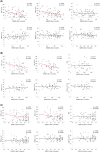Artificial intelligence-based analysis of body composition predicts outcome in patients receiving long-term mechanical circulatory support
- PMID: 38146680
- PMCID: PMC10834347
- DOI: 10.1002/jcsm.13402
Artificial intelligence-based analysis of body composition predicts outcome in patients receiving long-term mechanical circulatory support
Abstract
Background: Obesity is a known cardiovascular risk factor and associated with higher postoperative complication rates in patients undergoing cardiac surgery. In heart failure (HF), conflicting evidence in terms of survival has been reported, whereas sarcopenia is associated with poor prognosis. An increasing number of HF patients require left ventricular assist device (LVAD) implantations. The postoperative mortality has improved in recent years but is still relatively high. The impact of body composition on outcome in this population remains unclear. The aim of this investigation was to examine the preoperative computed tomography (CT) body composition as a predictor of the postoperative outcome in advanced HF patients, who receive LVAD implantations.
Methods: Preoperative CT scans of 137 patients who received LVADs between 2015 and 2020 were retrospectively analysed using an artificial intelligence (AI)-powered automated software tool based on a convolutional neural network, U-net, developed for image segmentation (Visage Version 7.1, Visage Imaging GmbH, Berlin, Germany). Assessment of body composition included visceral and subcutaneous adipose tissue areas (VAT and SAT), psoas and total abdominal muscle areas and sarcopenia (defined by lumbar skeletal muscle indexes). The body composition parameters were correlated with postoperative major complication rates, survival and postoperative 6-min walk distance (6MWD) and quality of life (QoL).
Results: The mean age of patients was 58.21 ± 11.9 years; 122 (89.1%) were male. Most patients had severe HF requiring inotropes (Interagency Registry for Mechanically Assisted Circulatory Support [INTERMACS] profile I-III, 71.9%) secondary to coronary artery diseases or dilated cardiomyopathy (96.4%). Forty-four (32.1%) patients were obese (body mass index ≥ 30 kg/m2 ), 96 (70.1%) were sarcopene and 19 (13.9%) were sarcopene obese. Adipose tissue was associated with a significantly higher risk of postoperative infections (VAT 172.23 cm2 [54.96, 288.32 cm2 ] vs. 124.04 cm2 [56.57, 186.25 cm2 ], P = 0.022) and in-hospital mortality (VAT 168.11 cm2 [134.19, 285.27 cm2 ] vs. 135.42 cm2 [49.44, 227.91 cm2 ], P = 0.033; SAT 227.28 cm2 [139.38, 304.35 cm2 ] vs. 173.81 cm2 [97.65, 254.16 cm2 ], P = 0.009). Obese patients showed no improvement of 6MWD and QoL within 6 months postoperatively (obese: +0.94 ± 161.44 months, P = 0.982; non-obese: +166.90 ± 139.00 months, P < 0.000; obese: +0.088 ± 0.421, P = 0.376; non-obese: +0.199 ± 0.324, P = 0.002, respectively). Sarcopenia did not influence the postoperative outcome and survival within 1 year after LVAD implantation.
Conclusions: Preoperative AI-based CT body composition identifies patients with poor outcome after LVAD implantation. Greater adipose tissue areas are associated with an increased risk for postoperative infections, in-hospital mortality and impaired 6MWD and QoL within 6 months postoperatively.
Keywords: artificial intelligence; body composition; cachexia; left ventricular assist device; obesity paradox; sarcopenia.
© 2023 The Authors. Journal of Cachexia, Sarcopenia and Muscle published by Wiley Periodicals LLC.
Conflict of interest statement
IAJ received speaker honoraria from AstraZeneca GmbH and Abiomed outside of the submitted work. FS received institutional grants from Novartis and Abbott, non‐financial support from Medtronic and institutional fees (speaker honoraria) from Orion Pharma and AstraZeneca GmbH outside of the submitted work. LR received a doctoral scholarship from the German Heart Foundation during the conduct of the project FrailtyVAD‐Tx and reports share holdings of Allianz SE, Carl Zeiss Meditec AG, CompuGroup Medical SE & Co. KGaA, Evotec SE and Fresenius Medical Care AG & Co. KGaA outside of the submitted work. EP declares financial activities in proctoring and lecturing for Abiomed GmbH, Abbott GmbH & Co. KG and Medtronic and participates in the advisory board for FineHeart. All the other authors have nothing to declare related to this work.
Figures



References
-
- Rehman SM, Elzain O, Mitchell J, Shine B, Bowler IC, Sayeed R, et al. Risk factors for mediastinitis following cardiac surgery: the importance of managing obesity. J Hosp Infect 2014;88:96–102. - PubMed
-
- Goh SSC. Post‐sternotomy mediastinitis in the modern era. J Card Surg 2017;32:556–566. - PubMed
-
- Serban C, Arinze JT, Starreveld R, Lanters EAH, Yaksh A, Kik C, et al. The impact of obesity on early postoperative atrial fibrillation burden. J Thorac Cardiovasc Surg 2020;159:930–938.e2. - PubMed
-
- O'Sullivan KE, Byrne JS, Hudson A, Murphy AM, Sadlier DM, Hurley JP. The effect of obesity on acute kidney injury after cardiac surgery. J Thorac Cardiovasc Surg 2015;150:1622–1628. - PubMed
MeSH terms
LinkOut - more resources
Full Text Sources
Medical
Research Materials
Miscellaneous

